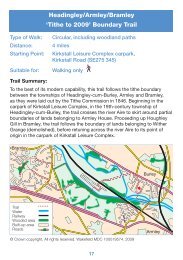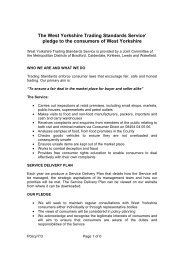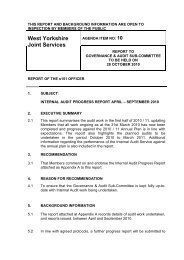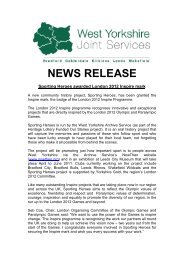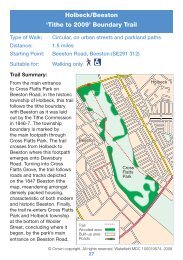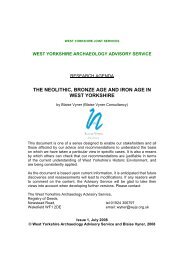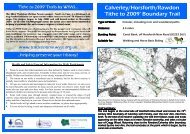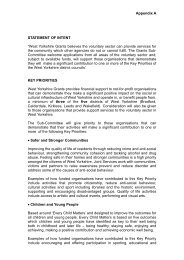Collections Guide - West Yorkshire Joint Services
Collections Guide - West Yorkshire Joint Services
Collections Guide - West Yorkshire Joint Services
Create successful ePaper yourself
Turn your PDF publications into a flip-book with our unique Google optimized e-Paper software.
(WYL2072) 1915–1916 Mark Wood, 15 th Battalion <strong>West</strong> <strong>Yorkshire</strong> Regiment (‘TheLeeds Pals’), First World War diary of a ‘Lance Jack’, detailing his service in Egyptand FranceThe final number of ‘Leeds Pals’ eventually rose to approximately 2,000. It would appear that each manchosen to be a Pal had something to offer, be it previous military experience, leadership qualities or physicalprowess. A certain high standard had been set and each individual reached this, although the average agewas 20-21 years old. Training was rigorous and took place at Colsterdale in the <strong>Yorkshire</strong> Dales. France wasexpected to be the Pals first destination but this was not so. Early December 1915 saw the first group of Palsset sail for Suez. Inevitably France was to be for many of the Pals their final destination. On 1 March 1916the Pals set sail for Marseilles as the Battle of the Somme became imminent. The battle was to prove tragicfor them. Twenty-four Leeds Pal’s officers went over the top with their men on 1 July 1916. Approximately750 out of 900 involved in the Somme died. The Leeds Pals suffered in their attack on Serre. Thirteenofficers killed, with two more dying of wounds and 209 other ranks killed with a further 24 dying of wounds. Itwas reported at the time that there was not a street in Leeds that did not have at least one house withcurtains drawn in mourning. The survivors of this and later battles came home after the War to receive nocounselling or compensation - they just got on with their lives. The British realised that the decision inDecember 1915 to evacuate the Gallipoli peninsula would release Turkish troops for operations elsewhere.The Turks had already attempted to take control of the Suez Canal in February 1915, hoping to gain supportfrom Egyptian nationalists opposed to British rule. With this in mind, it was decided to stiffen the defencesaround the canal. Rumours that the "Pals" were going to France were soon dispelled when the transportsection of 102 men, under the command of Captain Boardall and Lieutenants Smith and Everitt leftDevenport on 6 December on board HMS Shropshire, bound for Egypt. The remainder of the battalion, plustheir pioneers (12th K.O.Y.L.I.) and Army Service Corps personnel left Liverpool along with the rest of 93brigade (6,000 troops) on board The Empress of Britain (a converted liner) on 7 December for the samedestination. The Shropshire arrived at Port Said in December. The "Pals" disembarked on the 22nd andmarched to No 8 camp, were they stayed acclimatising until the 30th then moved 32 miles up the canal toguard various points in the desert. By late February 1916, the threat of invasion along the Suez Canal haddecreased to such an extent that on 1 March, after 3 months of sun, sand, and a few minor skirmishes, thebattalion returned to Port Said, gathered up their equipment and stores and marched on board the troopshipHMT Asconia for the journey to France (further information can be found at: http://leedspals.com/deployment/egypt,accessed 24/04/13).(WYL793) 1859–1968 <strong>West</strong> Riding of <strong>Yorkshire</strong> Rifle Volunteer Corps, recordsincluding battalion orders, letter books, war diary, scrapbooksThe "Leeds Rifles" were founded in 1859. The title has been ascribed successively to: 11th, later 7th, <strong>West</strong><strong>Yorkshire</strong> Rifle Volunteer Corps (c1870); 3rd Volunteer Battalion of the Prince of Wales Own <strong>West</strong> <strong>Yorkshire</strong>Regiment (c1900); 7th and 8th Battalions (T.A) <strong>West</strong> <strong>Yorkshire</strong> Regiment (1910).



